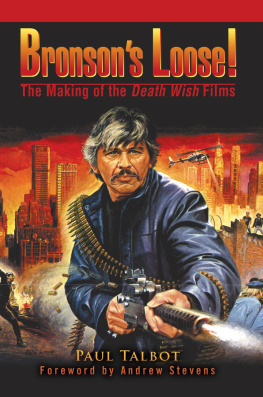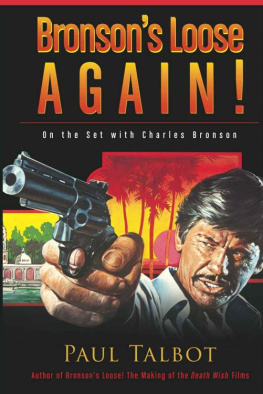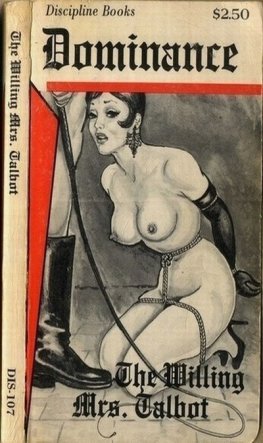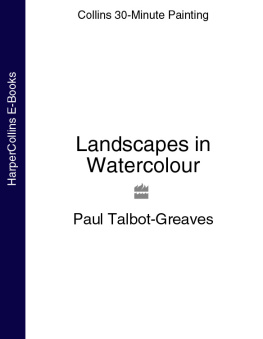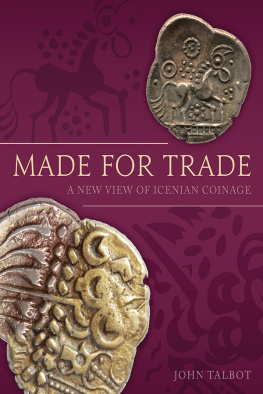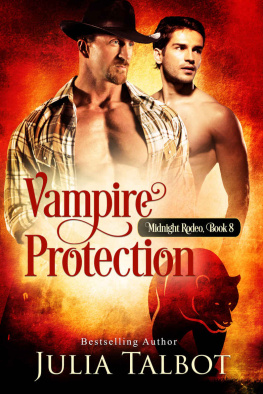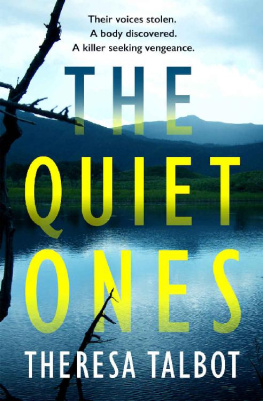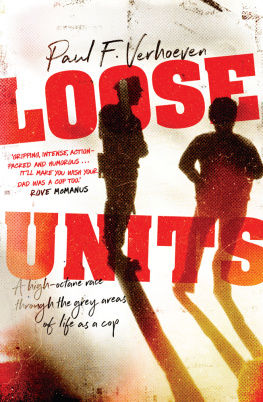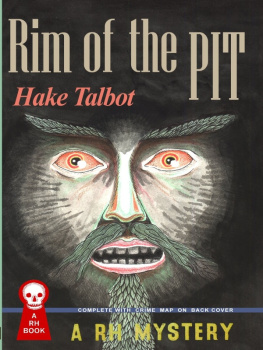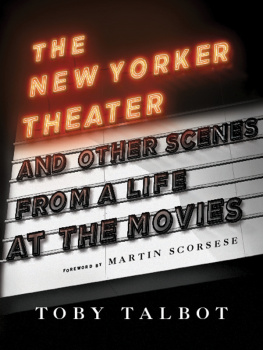Paul Talbot - Bronsons Loose!: The Making of the Death Wish Films
Here you can read online Paul Talbot - Bronsons Loose!: The Making of the Death Wish Films full text of the book (entire story) in english for free. Download pdf and epub, get meaning, cover and reviews about this ebook. year: 2006, publisher: iUniverse, genre: Non-fiction. Description of the work, (preface) as well as reviews are available. Best literature library LitArk.com created for fans of good reading and offers a wide selection of genres:
Romance novel
Science fiction
Adventure
Detective
Science
History
Home and family
Prose
Art
Politics
Computer
Non-fiction
Religion
Business
Children
Humor
Choose a favorite category and find really read worthwhile books. Enjoy immersion in the world of imagination, feel the emotions of the characters or learn something new for yourself, make an fascinating discovery.
- Book:Bronsons Loose!: The Making of the Death Wish Films
- Author:
- Publisher:iUniverse
- Genre:
- Year:2006
- Rating:4 / 5
- Favourites:Add to favourites
- Your mark:
- 80
- 1
- 2
- 3
- 4
- 5
Bronsons Loose!: The Making of the Death Wish Films: summary, description and annotation
We offer to read an annotation, description, summary or preface (depends on what the author of the book "Bronsons Loose!: The Making of the Death Wish Films" wrote himself). If you haven't found the necessary information about the book — write in the comments, we will try to find it.
Paul Talbot: author's other books
Who wrote Bronsons Loose!: The Making of the Death Wish Films? Find out the surname, the name of the author of the book and a list of all author's works by series.
Bronsons Loose!: The Making of the Death Wish Films — read online for free the complete book (whole text) full work
Below is the text of the book, divided by pages. System saving the place of the last page read, allows you to conveniently read the book "Bronsons Loose!: The Making of the Death Wish Films" online for free, without having to search again every time where you left off. Put a bookmark, and you can go to the page where you finished reading at any time.
Font size:
Interval:
Bookmark:
Bronsons Loose!
The Making of the Death Wish Films
Paul Talbot
iUniverse, Inc.
New York Lincoln Shanghai
Bronsons Loose! The Making of the Death Wish Films
Copyright 2006 by Paul Talbot
All rights reserved. No part of this book may be used or reproduced by any means, graphic, electronic, or mechanical, including photocopying, recording, taping or by any information storage retrieval system without the written permission of the publisher except in the case of brief quotations embodied in critical articles and reviews.
iUniverse books may be ordered through booksellers or by contacting:
iUniverse
2021 Pine Lake Road, Suite 100
Lincoln, NE 68512
www.iuniverse.com
1-800-Authors (1-800-288-4677)
This book is an unofficial companion to the Death Wish film series. It is not authorized or endorsed by any motion picture studio or production company.
ISBN-13: 978-0-595-37982-8 (pbk)
ISBN-13: 978-0-595-82352-9 (ebk)
ISBN-10: 0-595-37982-6 (pbk)
ISBN-10: 0-595-82352-1 (ebk)
Printed in the United States of America
For Marie Victoria and her grandparents
Contents
Extreme thanks is extended to Dana Barron, Steve Carver, Brian Garfield, Allan
A. Goldstein, Gail Morgan Hickman, Kevyn Major Howard, Pancho Kohner, the late Bobby Roberts, Todd Roberts, and Michael Winner for graciously sharing information on the Death Wish movies; Andrew Stevens for writing the foreword; Michele Basle and John Fraser for helping to arrange interviews; film historians Keith Bailey, John Charles and Chris Poggiali for providing valuable information; Tim Lucas of Video Watchdog and Michael Weldon of Psychotronic Video for inspiration; Charles Brower for his exceptional editing skills, Tommy Faircloth for technical assistance, and Jamie Rexinger for graphic design
I had the opportunity to work with Charles Bronson on two occasions in the early 1980s. When I was filming Death Hunt (1981), in Banff, Alberta, Canada, there were two distinct presences on the set. Charles Bronsonthe legendary stoic actor, with chiseled featureswas a health nut and a family man who kept to himself and was quiet and feared by all. Bronsons persona was in sharp contrast to the wisecracking, social, hard-drinking, chain-smoking Lee Marvin, who was never at a loss for a story, a laugh, or an anecdote. Curiously, the two stars had an enormous amount of respect for each other despite their diametrically opposed lifestyles. I, as a young actor, and my colleagues of all ages on the film had deep personal and professional respect for both men as well.
In 1983, when I appeared in 10 to Midnight as Bronsons young detective partner, I had greater opportunity to spend quality one-on-one time with Charlie. I had learned on the set of Death Hunt that Bronson did not like to be approached or pursued in any way (particularly for idle chit-chat) and, much like an untamed animal, one had to let Bronson come to him.
The most fascinating example of me using reverse psychology was on the set of 10 to Midnight. As Charlie and I were sitting in an unmarked police car, awaiting lighting for a particular scene, I sat in the drivers seat reading my newspaper as Bronson sat next to me in the passenger seat. I glanced at Charlie and nodded. He nodded back and sucked his teeth. As I turned page after page of my newspaper, Bronson eventually became bored and started to hum. After the humming subsided, he finally turned to me and said, Good morning, Andrew, to which I replied Good morning, Charlie (nothing more) and continued to read. (My silence was luring him in.) Since there was no apparent threat, the more coy and distant I appeared, the more Bronson pursued me and the more he opened up. Little by little, I questioned him about working with Sergio Leone, who, according to Bronson, shot without sound and played music specific to each character before starting each scene. Now thats acting! said Bronson. He waxed poetic and reminisced about appearing on stage playing a blacksmith and feeling the power that a riveting performance could bring to an actor. He showed a deep love and passion for the art of acting and the empathy and sympathy that a character could illicit from an audience, such as in his memorable role as Danny in The Great Escape.
Charlie was, in his heart and soul, the antithesis of that stoic, unapproachable persona that became known as Bronson in his later years. Unfortunately, with time and stereotypical roles, his public sometimes forgot that Charles Buchinsky, the coal miners son, was a talented actor and an artist at heart.
Andrew Stevens has appeared in such films as The Boys in Company C (1978), for which he received a Golden Globe nomination, The Fury (1978), The Seduction (1982), and Night Eyes (1990). His numerous producing credits include The Boondock Saints (1999), The Whole Nine Yards (2000), Get Carter (2000), and The In-Laws (2003).
The creation of the MPAA rating system in the late 1960s allowed filmmakers to explore previously taboo themes and social issues. Movies were soon filled with explicit nudity, language, and violence. By the early 1970s, the film industry was using the newfound freedom to assault audiences with realistic re-creations of the seedy corners of society.
Crime was rampant in U.S. cities in the early 1970s, when muggings, murders, rapes, and riots were constantly being reported in the news. Mainstream American movies like The French Connection (1971), Shaft (1971), Dirty Harry (1972), Across 110 th Street (1972), The Don Is Dead (1973), The Friends of Eddie Coyle (1973), Superfly (1972), and Serpico (1973) depicted contemporary urban violence realistically, and it seemed that graphic cinematic mayhem had been pushed to the limit.
But when Death Wish hit New York movie screens in the summer of 1974, it stunned the jaded audiences with its story about an average citizen who stalks the streets with a pistol to randomly gun down the type of punks who had brutally and senselessly assaulted his wife and daughter. Audiences, particularly those in New York and especially those who had been victims of crime themselves, screamed and applauded with delight as star Charles Bronson responded on screen the way they wished they could have in real life. Some critics cheered along with the paying audience, but other reviewers were appalled by the violence on the screen and the gleeful sadism in the theater.
With his squinty eyes, stoic expression, bulky physique, and cracked, unhandsome face, Bronson was an unlikely candidate for screen stardom, but his effortless charisma and powerful presence made it impossible for audiences to ignore him. The fifty-four-year-old Bronson was already a huge international movie icon in 1974, but Death Wish (the stars first U.S. blockbuster) created such controversy and excitement that it became the movie he was best-known for and forever identified with. The character of vigilante Paul Kersey was a role that Bronson would play over again in four sequels made over the next twenty years.
Most movie sequels are inferior to the original film, and the Death Wish follow-ups are no exception. But all four of the Death Wish sequels were money-makers and were reflections of the current wave of action moviemaking.
The gruesome Death Wish II was released in 1982, shortly after Ronald Reagan was elected president of the United States and the country was in a right-wing, eye-for-an-eye mood. By the time the outrageous Death Wish 3 went into production in 1985, every action film was copying the format of the blockbuster Rambo: First Blood Part II (1985), and the Kersey character was turned into a one-man army with an unlimited supply of firepower to gun down an endless army of thugs. The Death Wish movies were no longer gritty, shocking, and disturbing depictions of real-life urban crime but garish comic-book fantasies with creative, over-the-top revenge sequences. No longer a complex character, Kersey was now a cartoon superhero with fearsome hand-to-hand combat skills and a constantly increasing arsenal of weapons.
Font size:
Interval:
Bookmark:
Similar books «Bronsons Loose!: The Making of the Death Wish Films»
Look at similar books to Bronsons Loose!: The Making of the Death Wish Films. We have selected literature similar in name and meaning in the hope of providing readers with more options to find new, interesting, not yet read works.
Discussion, reviews of the book Bronsons Loose!: The Making of the Death Wish Films and just readers' own opinions. Leave your comments, write what you think about the work, its meaning or the main characters. Specify what exactly you liked and what you didn't like, and why you think so.

